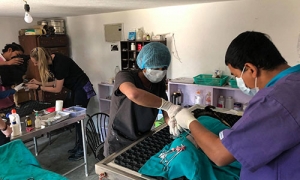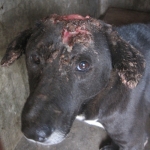KAT Centre in Nepal
Dear Dr. Hansen and the board of directors of Animal SOS
The Kathmandu Animal Treatment Centre (KAT Centre) would like to thank Animal SOS for the generous donation of US$1934 which was received on 20 April 2011. The KAT Centre is expending the funds throughout one year. This is a report on the first six months of use of the grant, and an additional report will be submitted one year after the funds were received.
The city of Kathmandu, Nepal is home to more than 20,000 street dogs. They are commonly afflicted with injuries from collisions with cars, starvation, open sores with maggot infections, severe skin problems such as mange, and infectious ailments. Some stray dogs in Nepal carry rabies and other dangerous diseases which put people, particularly children who often play in the streets, at risk.
The Kathmandu city government used to poison more than 10,000 street dogs each year with strychnine, in an attempt to control the canine population. This is a horrific form of death and it is ineffective because the remaining dogs breed and the population returns to its original size within a year.
The Kathmandu Animal Treatment Centre is a non-profit registered charitable organization dedicated to improving the welfare of Nepal’s animals. The goals of the KAT Centre are to create a healthy, stable street dog population and eliminate rabies in the Kathmandu Valley. Through an agreement between the KAT Centre and the government of Kathmandu, the government no longer poisons stray dogs in the areas where KAT works.
-

-

-
Kali – now ready to be adopted into a permanent home.
Animal Birth Control (ABC) program
The Kathmandu Animal Treatment Centre’s Animal Birth Control (ABC) program operates along the World Health Organization (WHO) guidelines for management of stray dog populations. KAT’s staff collects female street dogs who have not been sterilized (spayed) and lets them settle in kennels at the Centre for 12 to 24 hours. The animals are then sterilized, vaccinated for rabies, given ear notches to show they have been treated, and given individual tattoos for future identification. KAT’s vets also treat them for any existing health problems. After at least three days, if the animals are healthy and show no complications from the sterilization, they are released to the exact same places where they were collected.
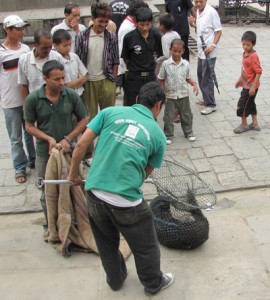
In the last six months, the KAT Centre has sterilized and vaccinated 524 street dogs. As a result of these efforts, Kathmandu’s dog population will decrease as dogs die naturally, rather than the population being limited by the number of dogs who die because they cannot find enough food.
Rescue & Treatment program
The KAT Centre’s Rescue & Treatment program is an essential component of the organization’s approach to improving animal welfare in Nepal. One aim of the program is to provide medical care to animals who are sick, injured, malnourished, and abused. Some of the animals KAT rescues are completely covered in mange or severely emaciated. On a larger scale, the second aim is to help establish a healthy dog community throughout the Kathmandu Valley.
In addition to giving severely needed and often life-saving veterinary treatment, the KAT Centre sterilizes every dog and cat who enters the program, so they do not produce more unwanted animals and exacerbate the pet overpopulation problem. KAT also vaccinates each animal for rabies. After they are fully restored to health, the organization ensures they go to a suitable environment. The KAT Centre provided veterinary treatment to 296 stray dogs and cats in the past six months (This is in addition to the 524 animals treated in the ABC program).
Public Education program
The KAT Centre’s Animal Birth Control (ABC) and Rescue & Treatment are complemented by a humane awareness program for children and adults.
Topics taught in the program include:
• Compassion for animals
• Rabies prevention, including how to identify potentially rabid dogs
• Avoiding dog bites
• How to care for pet dogs (because many Nepalis are unaware of animals’ needs)
• The importance of vaccinating and sterilizing dogs
• Proper waste disposal, because the number of stray dogs that an area can support is directly related to the amount of rubbish on the street.
The activities of the Public Education program include:
• Visits to orphanages and schools
• Booths and tables with banners and educational displays at public events
• Tours and an introduction to KAT’s programs for school groups and youth clubs who visit the Centre
• Posters throughout Kathmandu informing people of dogs who are available for adoption and the Centre’s work for animals in need
• Articles in magazines and newspapers about KAT and the plight of Kathmandu’s street animals
• Distribution of leaflets about the stray dog situation, KAT’s work to help stray dogs, and rabies awareness.
The KAT Centre uses every opportunity to educate the public to treat animals with care and compassion. While rescuing animals, the KAT team talks to local residents, distributes leaflets about proper care of animals, and encourages people to adopt pets and to contact the organization when they see animals who need help. Furthermore, the KAT Centre serves as a model of compassion for animals and is producing a shift in the public’s perspective about the animals with whom they share their city.
In the last six months, the KAT Centre’s staff visited 18 schools and educated 760 students. Additionally, many school groups and youth organizations visited the Centre.
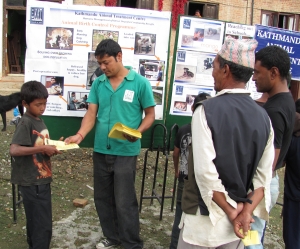
Integrated approach
In the summer of 2011, KAT’s three major programs – Animal Birth Control (ABC), Rescue & Treatment (for sick and injured animals) and Public Education – began to simultaneously target the same areas of the city of Kathmandu. Additionally, every Sunday, KAT’s vets and animal care staff travel through the current target area to provide on-site treatment to animals who need veterinary care but do not need to be sheltered during the treatment.
The KAT Centre began this integrated strategy in the area around Kalanki, and after sterilizing and vaccinating every possible female street dog in that area, KAT is now implementing its three major programs in greater Swayambhu which is just north of Kalanki. It is clear that this approach makes a lasting impact on the attitudes of the public towards stray dogs; for example, many people in these areas are calling KAT about animals in need of rescue who would have previously been apathetic about suffering animals.
Bungamati village vaccination program
The KAT Centre implemented its third rabies vaccination program in the village of Bungamati, on the outskirts of the Kathmandu Valley, from 15 through 18 August 2011. Bungamati has an abundance of street dogs and the villagers are concerned about the risk of a rabies outbreak. A team from the KAT Centre spent four days vaccinating close to 500 dogs in the area. They also provided on-site treatment to animals as needed, and educated the public about rabies prevention, care for animals, the importance of sterilization, and why KAT was implementing the program. Furthermore, the organization brought its Public Education program to two schools in Bungamati to reinforce the public awareness activities. The health of the dogs was better than in previous years, an indication that KAT’s previous awareness programs have made an impact.
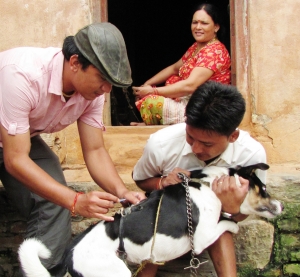
Sincerely,
Gregg Tully
Fundraising Adviser
Kathmandu Animal Treatment Centre
development@katcentre.org.np

